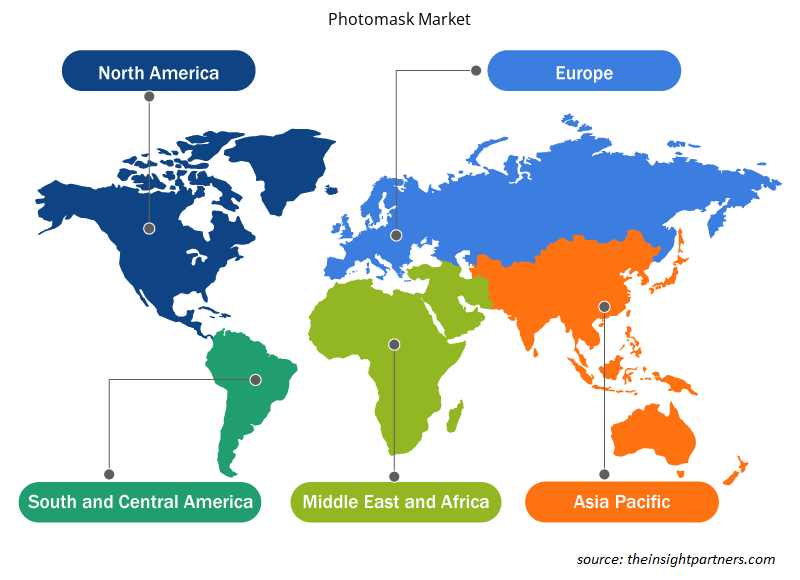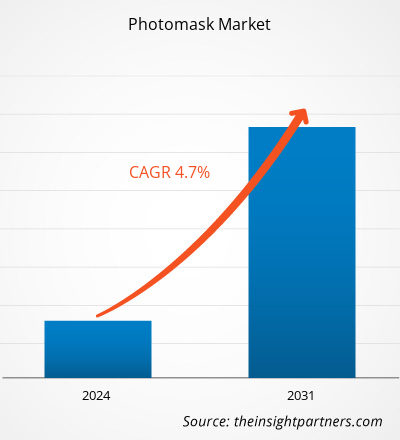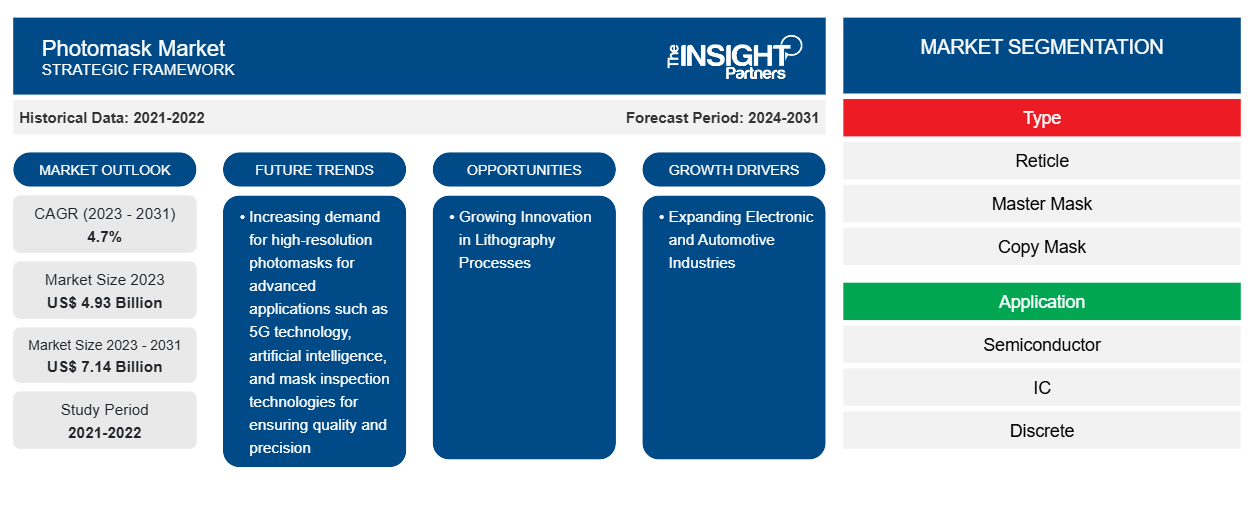Si prevede che la dimensione del mercato delle fotomaschere raggiungerà i 7,14 miliardi di dollari entro il 2031, rispetto ai 4,93 miliardi di dollari del 2023. Si prevede che il mercato registrerà un CAGR del 4,7% nel 2023-2031. La crescente domanda di fotomaschere ad alta risoluzione per applicazioni avanzate come la tecnologia 5G, l'intelligenza artificiale e le tecnologie di ispezione delle maschere per garantire qualità e precisione rimarrà probabilmente una tendenza chiave del mercato delle fotomaschere.
Analisi di mercato delle fotomaschere
Il mercato delle fotomaschere sta crescendo a un ritmo rapido a causa dell'espansione delle industrie elettroniche e automobilistiche e della crescente domanda di memorie e processori di elaborazione veloce. Il mercato si sta espandendo costantemente, guidato dalla crescente adozione di dispositivi semiconduttori avanzati. Inoltre, la crescente innovazione nei processi di litografia e la crescente produzione di automobili tecnologicamente avanzate stanno offrendo opportunità redditizie per la crescita del mercato.
Panoramica del mercato delle fotomaschere
Le fotomaschere sono strumenti di trasferimento di immagini realizzati esponendo o disegnando un pattern su un dispositivo cromato grezzo rivestito di resist. Sono composte da substrati solidi e trasparenti con uno strato superficiale opaco. Le fotomaschere contengono il layout IC che deve essere duplicato. Le fotomaschere stanno diventando sempre più popolari per il trasferimento accurato di pattern su wafer di silicio man mano che i transistor diventano più piccoli e più avanzati. Inoltre, la crescente necessità di fotomaschere per la produzione di chip di circuiti integrati complessi sta guidando il mercato.
Personalizza questo report in base alle tue esigenze
Riceverai la personalizzazione gratuita di qualsiasi report, comprese parti di questo report, o analisi a livello nazionale, pacchetto dati Excel, oltre a usufruire di grandi offerte e sconti per start-up e università
-
Scopri le principali tendenze di mercato in questo rapporto.Questo campione GRATUITO includerà analisi di dati che spaziano dalle tendenze di mercato alle stime e alle previsioni.
Driver e opportunità del mercato delle fotomaschere
L'espansione dell'industria elettronica e automobilistica sta guidando il mercato
Il settore dell'elettronica mondiale sta vivendo un'espansione straordinaria a causa della crescente domanda dei consumatori di gadget elettronici, dei progressi tecnologici e dell'introduzione dell'Internet of Things e delle tecnologie indossabili. L'International Trade Administration (ITA) prevede che il settore dell'elettronica mondiale dovrebbe superare i 5 trilioni di dollari entro il 2025, il che crea opportunità per i produttori di semiconduttori e guida il mercato delle fotomaschere durante il periodo di previsione. Inoltre, l'espansione dell'industria automobilistica e la crescente domanda di veicoli elettrici e tecnologia di guida autonoma tra i consumatori stanno guidando il mercato. I consumatori si stanno spostando verso l'adozione di veicoli connessi e sistemi di comunicazione e sicurezza migliorati, il che stimola lo sviluppo di dispositivi semiconduttori avanzati. Incrementando così la crescita del mercato delle fotomaschere.
Crescente innovazione nei processi litografici: un'opportunità nel mercato delle fotomaschere
La crescente innovazione nella litografia è fondamentale per consentire alla tecnologia di fabbricare dispositivi semiconduttori compatti e complessi con prestazioni ed efficienza migliorate. La litografia a raggi ultravioletti estremi (EUV) rappresenta un significativo progresso tecnologico nel settore dei semiconduttori. Secondo l'International Technology Roadmap of Semiconductors (ITRS), il numero di strumenti EUV forniti è cresciuto fino al 30% nel 2023 rispetto al 2022, indicando che il settore sta rapidamente adottando questa tecnologia litografica all'avanguardia. La litografia EUV consente dimensioni delle caratteristiche inferiori e una maggiore risoluzione, con conseguenti migliori prestazioni del chip e convenienza economica. Questi progressi tecnici attraggono fotomaschere su misura per applicazioni di litografia EUV, che dovrebbero creare opportunità sul mercato durante il periodo di previsione.
Analisi della segmentazione del rapporto di mercato di Photomask
I segmenti chiave che hanno contribuito alla derivazione dell'analisi di mercato delle fotomaschere sono tipologia, applicazione e settore verticale dell'utente finale.
- In base al tipo, il mercato delle fotomaschere è suddiviso in reticle, master mask e copy mask. Il segmento master mask ha detenuto una quota di mercato maggiore nel 2023.
- Sulla base dell'applicazione, il mercato è segmentato in semiconduttori e IC, discreti, optoelettronici, dispositivi di visualizzazione, MEMS e altri. Il segmento semiconduttori e IC ha detenuto una quota di mercato maggiore nel 2023.
- In termini di verticale dell'utente finale, il mercato delle fotomaschere è categorizzato come semiconduttori e IC e display a schermo piatto. Il segmento semiconduttori e IC ha detenuto una quota di mercato maggiore nel 2023.
Analisi della quota di mercato di Photomask per area geografica
L'ambito geografico del rapporto sul mercato delle fotomaschere è suddiviso principalmente in cinque regioni: Nord America, Asia Pacifico, Europa, Medio Oriente e Africa e Sud America/Sud e Centro America.
In termini di fatturato, il mercato dell'Asia Pacifica ha rappresentato la quota di mercato più grande delle fotomaschere, a causa della presenza di una vasta industria elettronica in Cina, Corea del Sud e Taiwan. La crescita dell'industria elettronica aumenta la domanda di fotomaschere nella fabbricazione di semiconduttori. Secondo il Ministero del Commercio della Corea del Sud, le esportazioni di semiconduttori del paese sono aumentate del 12% nel primo trimestre del 2023 rispetto allo stesso periodo del 2022. La crescente domanda di semicontinuo tra i produttori per la produzione di apparecchiature e dispositivi elettronici sta creando opportunità per il mercato durante il periodo. Inoltre, gli investimenti della regione nello sviluppo tecnologico e infrastrutturale contribuiscono in modo significativo alla crescita del mercato globale delle fotomaschere.
Approfondimenti regionali sul mercato delle fotomaschere
Le tendenze regionali e i fattori che influenzano il mercato Photomask durante il periodo di previsione sono stati ampiamente spiegati dagli analisti di Insight Partners. Questa sezione discute anche i segmenti e la geografia del mercato Photomask in Nord America, Europa, Asia Pacifico, Medio Oriente e Africa e Sud e Centro America.

- Ottieni i dati specifici regionali per il mercato delle fotomaschere
Ambito del rapporto di mercato sulle fotomaschere
| Attributo del report | Dettagli |
|---|---|
| Dimensioni del mercato nel 2023 | 4,93 miliardi di dollari USA |
| Dimensioni del mercato entro il 2031 | 7,14 miliardi di dollari USA |
| CAGR globale (2023-2031) | 4,7% |
| Dati storici | 2021-2022 |
| Periodo di previsione | 2024-2031 |
| Segmenti coperti |
Per tipo
|
| Regioni e Paesi coperti |
America del Nord
|
| Leader di mercato e profili aziendali chiave |
|
Densità dei player del mercato Photomask: comprendere il suo impatto sulle dinamiche aziendali
Il mercato Photomask Market sta crescendo rapidamente, spinto dalla crescente domanda degli utenti finali dovuta a fattori quali l'evoluzione delle preferenze dei consumatori, i progressi tecnologici e una maggiore consapevolezza dei vantaggi del prodotto. Con l'aumento della domanda, le aziende stanno ampliando le loro offerte, innovando per soddisfare le esigenze dei consumatori e capitalizzando sulle tendenze emergenti, il che alimenta ulteriormente la crescita del mercato.
La densità degli operatori di mercato si riferisce alla distribuzione di aziende o società che operano in un particolare mercato o settore. Indica quanti concorrenti (operatori di mercato) sono presenti in un dato spazio di mercato in relazione alle sue dimensioni o al valore di mercato totale.
Le principali aziende che operano nel mercato delle fotomaschere sono:
- Società di riproduzioni avanzate
- Compugraphics International Limited
- Dai Nippon Printing Co., Ltd.
- Società HOYA
- LG Innotek Co., Ltd.
- Nippon Filcon Co., Ltd.
Disclaimer : le aziende elencate sopra non sono classificate secondo un ordine particolare.

- Ottieni una panoramica dei principali attori del mercato Photomask
Notizie e sviluppi recenti del mercato delle fotomaschere
Il mercato delle fotomaschere viene valutato raccogliendo dati qualitativi e quantitativi dopo la ricerca primaria e secondaria, che include importanti pubblicazioni aziendali, dati associativi e database. Di seguito è riportato un elenco degli sviluppi nel mercato delle fotomaschere e delle strategie:
- Nel febbraio 2024, Toppan Printing Co, Ltd. ha annunciato di aver stipulato un accordo congiunto di ricerca e sviluppo con IBM relativo al nodo semiconduttore logico da 2 nanometri (nm), utilizzando la litografia ultravioletta estrema (EUV). Questo accordo include anche la capacità di sviluppo di fotomaschere EUV ad alto NA su semiconduttori di prossima generazione. (Fonte: Toppan Printing Co, Ltd., comunicato stampa, 2023)
- Nel dicembre 2023, Dai Nippon Printing Co., Ltd. ha sviluppato con successo un processo di produzione di fotomaschere in grado di ospitare il processo litografico a 3 nanometri (10-9 metri) che supporta la litografia a raggi ultravioletti estremi (EUV), il processo all'avanguardia per la produzione di semiconduttori. (Fonte: Dai Nippon Printing Co., Ltd., comunicato stampa, 2023)
Copertura e risultati del rapporto di mercato di Photomask
Il rapporto "Dimensioni e previsioni del mercato Photomask (2021-2031)" fornisce un'analisi dettagliata del mercato che copre le seguenti aree:
- Dimensioni e previsioni del mercato a livello globale, regionale e nazionale per tutti i segmenti di mercato chiave coperti dall'ambito
- Dinamiche di mercato come fattori trainanti, vincoli e opportunità chiave
- Principali tendenze future
- Analisi dettagliata delle cinque forze PEST/Porter e SWOT
- Analisi di mercato globale e regionale che copre le principali tendenze di mercato, i principali attori, le normative e gli sviluppi recenti del mercato
- Analisi del panorama industriale e della concorrenza che copre la concentrazione del mercato, l'analisi della mappa di calore, i principali attori e gli sviluppi recenti
- Profili aziendali dettagliati
- Analisi storica (2 anni), anno base, previsione (7 anni) con CAGR
- Analisi PEST e SWOT
- Valore/volume delle dimensioni del mercato - Globale, Regionale, Nazionale
- Industria e panorama competitivo
- Set di dati Excel
Report recenti
Testimonianze
Motivo dell'acquisto
- Processo decisionale informato
- Comprensione delle dinamiche di mercato
- Analisi competitiva
- Analisi dei clienti
- Previsioni di mercato
- Mitigazione del rischio
- Pianificazione strategica
- Giustificazione degli investimenti
- Identificazione dei mercati emergenti
- Miglioramento delle strategie di marketing
- Aumento dell'efficienza operativa
- Allineamento alle tendenze normative























 Ottieni un campione gratuito per - Mercato delle fotomaschere
Ottieni un campione gratuito per - Mercato delle fotomaschere